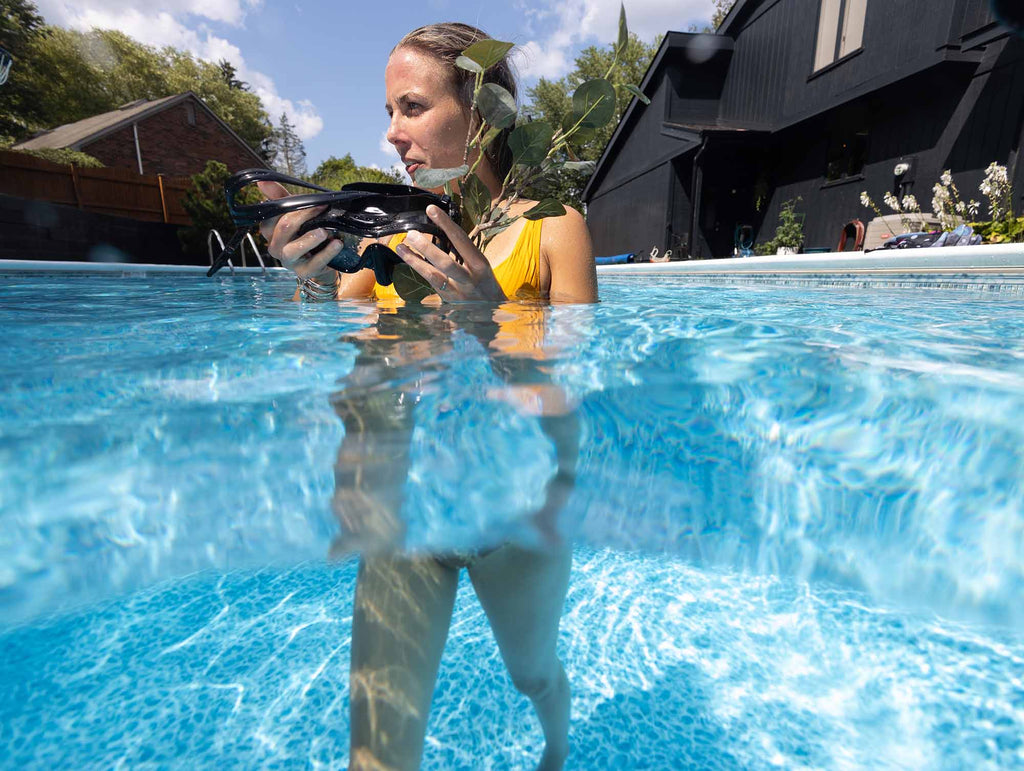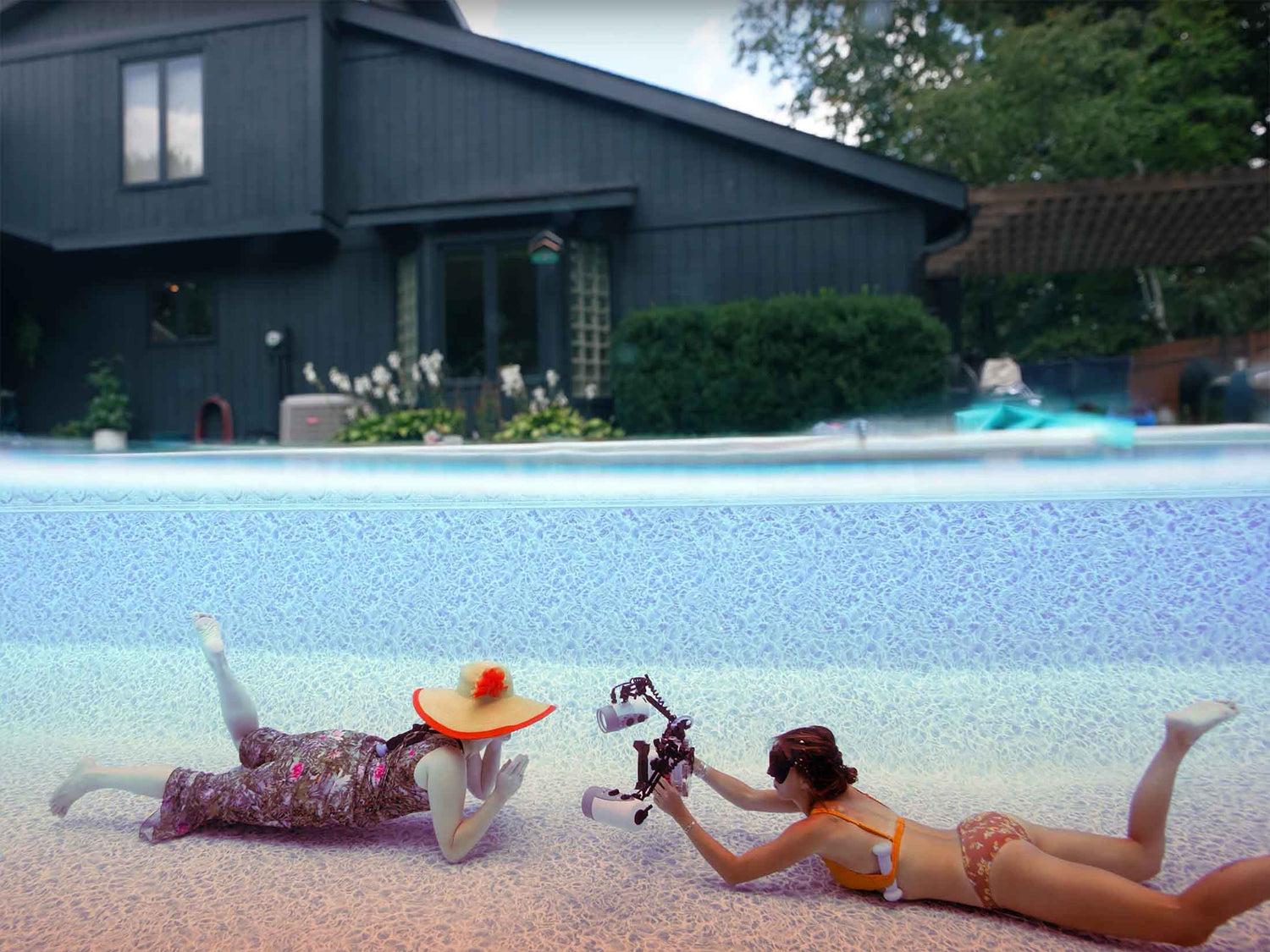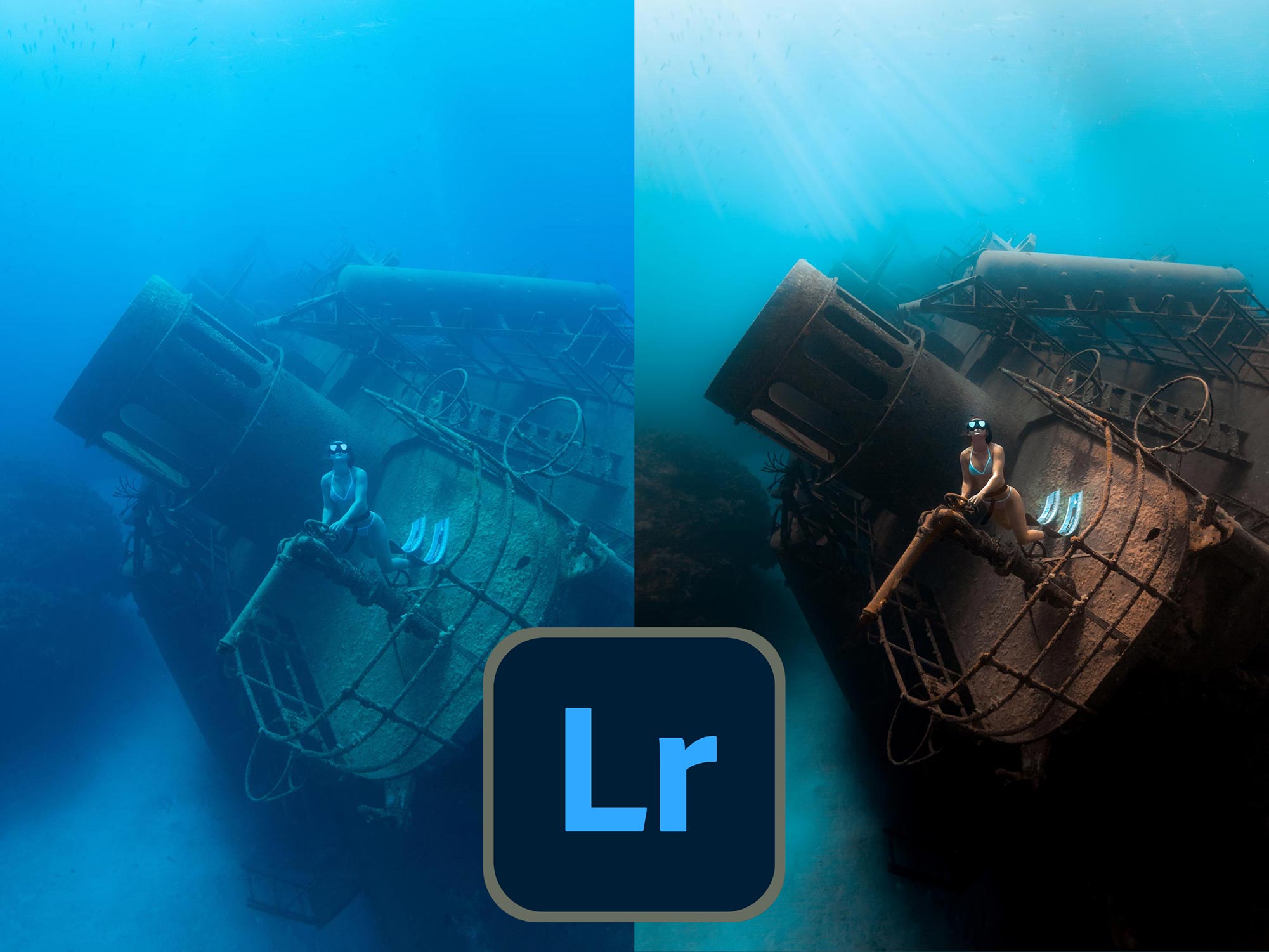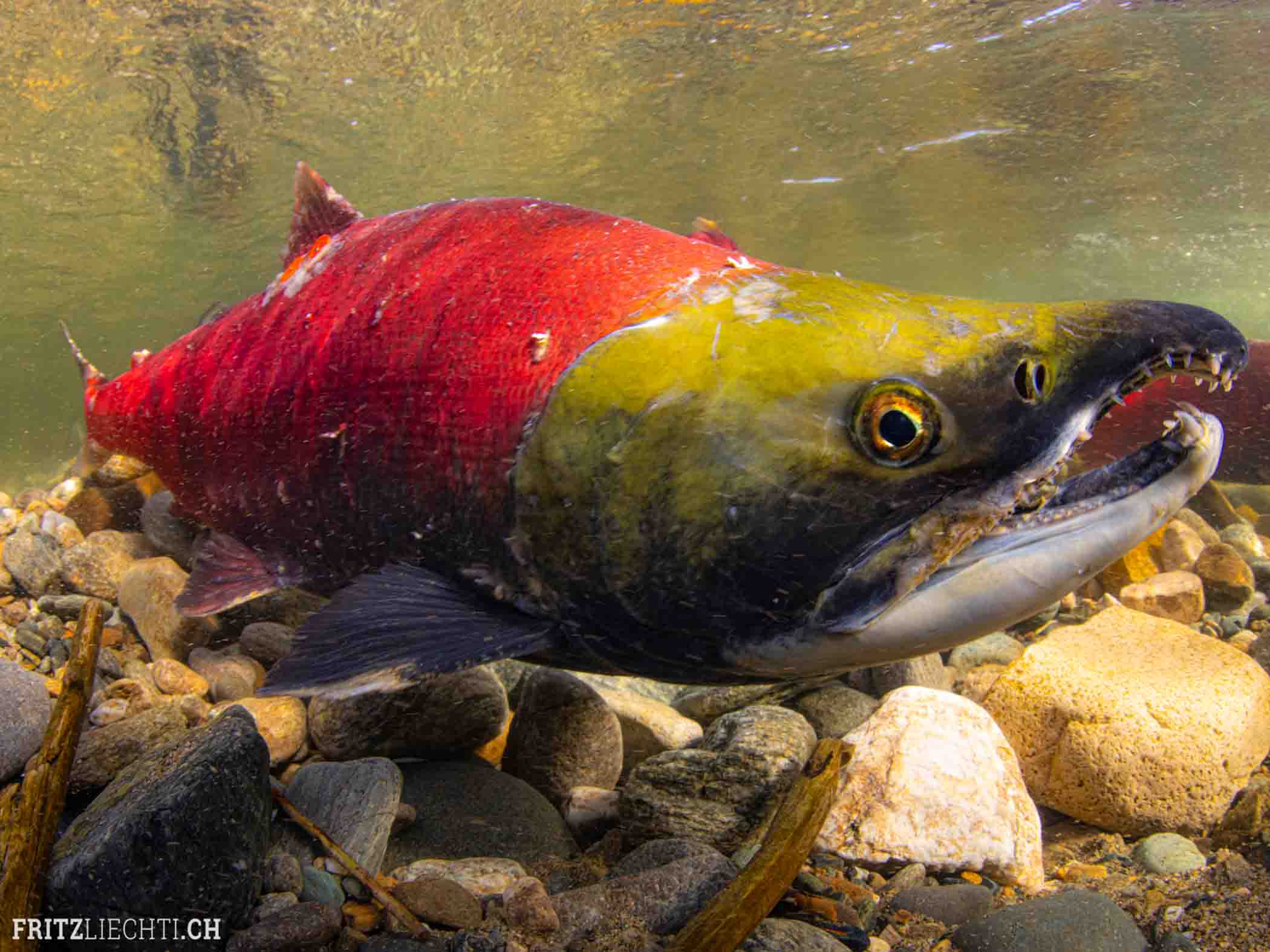We are arguably more qualified than most to start out as “beginners” in underwater portrait photography. Jean had been an active diver for nearly 20 years, rarely diving without a camera in her hands. In her first two years with Ikelite, Peach had learned the ins-and-outs of almost everything we do from production to shipping, sales, marketing, and even travel to dive shows.
In spite of our pedigrees, we found ourselves a bit underwater on our first-time pool photoshoot. Thinking of trying this at home? Learn from our experiences of what we did wrong and what we did right, plus some insider tips from a couple of Ikelite Ambassadors. You can also check out our image gallery from this photoshoot - The Results: First Time Underwater Pool Photoshoot.
Preparation
DENISE: I’m a big believer in preparation as a key to success, especially when taking on a new adventure, skill, etc. In this case, preparation was key to helping me feel comfortable underwater and behind the lens, and not like a fish out of water.
JEAN: I tend to leave most things to the last minute, but I still felt relatively prepared for what we were doing. I contacted Karen Bagley about borrowing the red dress, and we set up the photo equipment the afternoon before. The morning of the shoot we picked up coffee and snacks on our way to the pool.

Denise holds a sprig of fake eucalyptus we were attempting to use for a foreground blur effect.
DENISE: I scoured our Photo School articles for pool photography content, we looked up inspiration photos, and we planned out a general outline of the day, the poses, and the shots we wanted to get. The pool photography articles were endlessly helpful, as they provided professional tips and insights that were a good base knowledge to start from, although an Alison Bounce or Karen Bagley workshop would have been the ultimate form of preparation. The inspiration photos were key to helping us form our own vision and clarify a concise set of looks we were going for. Having an outline and general workflow for the day helped keep us on track and organized too.
JEAN: Even though we communicate with pool photographers every day and are good friends with plenty of them, we didn’t bother to get any direct advice whatsoever before going in the pool. I am sure our shoot would have gone more smoothly if we had used the resources available to us because there really is no substitute for one-on-one advice from a professional.
ALISON BOUNCE on Safety: Safety is the basis of the underwater practice. It defines the conditions of the shooting. It seems obvious to me to establish a solid framework for my sessions in order to ensure the protection of my clients and my assistants, of my equipment as well as my own. At each photo session, the photographer commits the life of his clients, his own responsibility as well as that of the people participating in the shooting. Establishing a secure framework must be his first concern. I recommend that you are always accompanied during your photo shoot and that you set up a pool watch with a lifeguard. Ask the essential questions to your muses to know their aquatic ease. Can they swim? Open their eyes underwater? Do they have any stress?
Equipment
JEAN: We ended up choosing the housing for the Canon EOS R camera and two DS160 II strobes.
DENISE: As someone newer to underwater photography I found the Canon EOS R as a pretty user-friendly camera that allowed me to focus on my subject and surroundings instead of on the camera. Having the TTL Converter made using the strobes a breeze too, with my only real adjustments being to the angle of the strobes as we moved around in the water and changed compositions.
JEAN: I had the idea to pick up the Canon RF 16mm wide angle the day before as I thought it would be a nice application for the lens behind a Compact 8” Dome Port. Occasionally during the shoot we wanted to shoot wider so I can see why Karen Bagley favors the massive Canon EF 11-24mm lens.
DENISE: As far as non-camera related equipment goes I learned pretty quickly that a weight belt can make a huge difference.

Sharing image reviews regularly in between shots can help the model to make adjustments to body and face positioning which will result in a better end image.
Location/Background
DENISE: We were afforded a fantastic (and heated!) pool that was a great location for what we were doing – learning. Being in a temperate pool allowed me the comfort of time and movement, I felt no rush to get out of the pool because I was too chilly and the warmth of the pool made moving around to capture different angles easy and comfortable.
KIMBER KIEFER on Location: If shooting in a pool look into options for having it heated to a comfortable temperature and the chemicals adjusted to be easier on the eyes.
JEAN: The pool we were shooting in was about 3-4 feet (1 meter) deep the whole way across. This made it easy to pop up for breaths in between shots, but I did find it a little limiting on what kind of poses I could do.
DENISE: In retrospect, a pool with a deep end would have been great asset – more room for flowing fabric, unique poses, and a seemingly “endless” background.
JEAN: We gave no real thought to the background on the photos and somehow I though it would magically bokeh into something neutral. I am sure I could do a lot of work in Photoshop to replace it with solid color but it wasn’t something I was prepared for. Shooting with a solid color backdrop would have been ideal. While lying in repose we added a bedsheet at the last minute and it made a huge difference. The bed sheet still had striping – we took what we could get – but it was subtle and gave us a lot more contrast and emphasis on the subject.

It takes a village sometimes. John Brigham is on fabric management duty while Denise gives guidance on posing for the next series of shots.
Costumes
JEAN: We did some things right and some things wrong when it came to costumes. The black yoga outfit was a dud for us because it does not reflect light from the strobes and it did nothing at all for me underwater. Skin tones are already tough to represent correctly when shooting through water and the black contrast just made matters worse.
DENISE: My biggest lesson was this – practice with your fabrics first! We were fortunate to have a loaner dress from our ambassador Karen Bagley which was a long, flowing, beautiful red dress. It took us almost as much time to figure out how to work with the fabric as it did to photograph it.
JEAN: This costume gave a wonderful pop of color when the strobes hit it. However, I failed to solicit any advice when I was arranging the loan of the dress. We had no idea how to work with it and about 50% of the shooting time with this outfit was just trying to figure out how to create the right movement with the extra yards of fabric. I was pretty much constantly getting tangled up in it.

It’s easy to see how too much extra fabric can be dangerous to a model that’s not comfortable underwater. Jean frequently got tangled up in the long train of the dress. © 2022 Denise Pietsch
DENISE: Hint – it might require another set of hands. Once we got the flowing fabric situated, it presented really unique photographic opportunities. The play of light and shadow with the dress and surface of the water was mesmerizing all on its own!
DENISE: We also learned that while props (hats, fake flowers) can create memorable images, they’re also objects that require a set of hands, and if yours are busy modeling or using a camera it’s another element to choreograph and coordinate.
JEAN: The last green dress was much easier to wear underwater and I liked that it had a pattern. Green wasn’t the best choice of colors – it’s way too close to blue – so next time I would go for something with more pinks or oranges in it.
CHARLOTTE BORIES on Costumes: Although aquatic portraits often look light and fluid, the reality behind the shot is, well... a bit different! Once the fabric is waterlogged, it becomes heavier and — even though it seems to float with lightness — it can drag your model down, slow them down while swimming, or even wrap around their legs. During an underwater shoot in a not-so-shallow pool (or in the sea), a safety diver MUST be there. Safety first! I worked on my own for a long time, and I must say that it's quite a challenge. It is very difficult for a photographer to be both behind the lens and next to the model to adjust the costume or move the fabric. From the model's perspective, it's really complicated to deal with apnea, buoyancy and posing at the same time, while elegantly moving the fabric. Believe me, the presence of an assistant is definitely a game-changer!
JEAN: One thing I gave no thought to was the degradation of my makeup through the course of the day. It became very evident in the post-shoot edit. By the end of the day my foundation was patchy – to put it nicely – and my skin and lips were pale and colorless. Brighter lipstick shades, a foundation primer, and waterproof liquid blush would have helped a lot.
Poses
KIMBER KIEFER on Posing: A lot goes into the shoot on the model side: for example developing a vision, posing ideas, etc. Get in the bath or pool and practice opening your eyes and posing, so you know what to expect. Point your toes! The number one thing I stress is to relax, it is a key component. Make slow movements and try not to look like you’re squinting or holding your breath.
DENISE: As a former ballet teacher, I used to always tell my students that the catch-22 in dance is that you’re performing a physically taxing artform yet you’ve got to look completely at ease and graceful while doing it. I think the same can be said of hitting poses underwater - it’s definitely an artform that requires a sense of grace. Besides having to hold a pose in moving water and controlling for buoyancy, you’ve also got to present a natural sense of ease and all while holding your breath and fighting water rushing into your sinuses and ears! It’s not a task for the faint of heart, and much kudos to all the models out there who make this look easy.

It’s not easy to make your face look relaxed and natural when you’re half-drowning with water flooding your sinuses. Some of these poses - lying back facing the water - were actually the most difficult to execute.
JEAN: I wish I had spent more time visualizing what I wanted my body to look like underwater. I was looking at inspiration photos more as a photographer which left me more or less totally unprepared. After the fact, watching videos of other people shooting underwater, I notice a lot of models that are able to stand upright or assume a “falling” position while completely submerged. This seems to simplify posing especially when an elaborate outfit is involved.
ALISON BOUNCE on Posing: Before suggesting a pose to your muse, I recommend that you test it yourself so that you can imagine it and feel the body posture. This will allow you, if necessary, to correct the position of the limbs (arms, legs, curvature of the back, orientation of the head...) but also to show your model what you expect. A concrete demonstration will be much more effective than explanations that are too rich and not always explicit enough. Then ask your model to reproduce the gestures. If necessary, adjust the model again according to your feelings and the aesthetics. Also consider that games and exercises can help your models obtain the desired postures, as in terrestrial photography. It's up to you to imagine various scenarios.
DENISE: My goal, behind the lens, was to try and fire off as many shots as possible in unison with Jean hitting her pose and her comfort level.
JEAN: Going in to the shoot, the static yoga lotus pose seemed like it was going to be the most simple to execute. I was totally wrong and it turned out to be the most difficult for me. I had no weights and would easily get turned around underwater. This led to flailing arm movements as my legs were tangled up into a pretzel.

A shallow pool made it easy to pop up for a breath but also challenging when attempting free floating poses.
DENISE: In the beginning I would head underwater with Jean at the same time, but it would take a few seconds for her to get positioned, etc. and I found myself getting too many images of her preparing for the pose and not in the pose itself. Knowing the effort it takes to look effortless, I felt much better once I worked on my timing and found our groove. The key, for me, was giving Jean a few seconds to get underwater and situated before I went under and started shooting, this way we seemed to capture the poses a bit more easily.
JEAN: The final “serenity” pose when I was laying back on the pool steps looks the most peaceful but was also challenging to execute. Perhaps I was doing something really wrong, but I couldn’t do this without water flooding my nose and sinuses each time. It really gave me a new perspective on the water torture.
ALISON BOUNCE on Posing: Establish clear communication. On the surface, have a long discussion with your models; explain to them how you will proceed together. Make them feel comfortable and don't hesitate to give them simple instructions. Keep your sentences short; there are a lot of instructions for posing underwater that will be easier to understand if they are delivered in a few words. For example, I say: "I'll go under first. Wait three seconds after I leave to submerge yourself. Once you are underwater, 1 meter from the surface, take the pose. Remember to relax your face and close your eyes."
Technique
JEAN: Thankfully John Brigham was on shore duty advising us on settings and shooting technique as we went along. It was a sunny day so we kept the ISO low at 100. For anything relatively close-up, shutter speeds were about 1/125 or 1/160 with apertures between f/8 and f/11. Some of the shots of the red gown had to be taken quite far away- too far for an external flash to do much good underwater. Shutter speeds up to 1/800 were used to stop motion of the fabric.
In my opinion the color and vibrance brought out by the flash on the red fabric was difficult – maybe impossible – to get by color correction alone. It would be cool to try shooting a similar dress in a larger pool with multiple remote strobes triggered by the Optical Slave Converter.

Dropping in to test camera and strobe TTL settings. Over the course of the day our settings changed with movements of the sun and the model.
DENISE: Being surrounded by helpful professionals is certainly a plus. If I was unsure about a camera setting or how to properly position my strobes, I just had to ask. That being said, turning the advice into action was when I felt most comfortable with the equipment and when the equipment went from being an external object to being an extension of my vision.
My biggest learning curve here was to maneuver around the model and swim into the right positions to get the composition I was looking for. I must take for granted all the foot shuffling I do topside taking photos to get the right image. Underwater it took me a little bit to realize I’d need to shuffle around underwater too!
JEAN: I found we occasionally got caught up in a series of shots that had no real underwater element to them at all – aside from the fact that they were actually shot in the water. By this I mean there was no sense of weightlessness, no reflection, no mind-bending pose. They could have been easily taken on the surface – much more easily in fact. So my biggest takeaway on technique seems so, so obvious: It’s important to make the water an element in the scene.
Comfort
JEAN: Our few “easy” poses turned into an all-day shoot which wrapped at 5pm. We didn’t have a timer going, but I can say with confidence that we logged at least 6 hours underwater.
DENISE: The creature comforts we brought along for the photoshoot were crucial! Having a warm robe to wear between costume changes, good snacks to keep us satiated, and coffee to keep us energized made a physically demanding day that much more comfortable.
JEAN: People laughed when we rolled in at 9am with donuts, chips, sandwiches, and Oreos. But by the end of the day nothing went un-touched. Sugar, caffeine, and carbs are a sure way to keep people going through a challenging shoot.

Body temperature drops quickly underwater and comfort is key to reduce stress during a pool shoot. We were glad we have warm robes and snacks on hand for surface intervals.
DENISE: Having a certain rapport with the people you’re working with is also a great bonus too. Whenever there’s a demanding task at hand, having a comfort level with the people you’re working with can make navigating and communicating that much easier.
JEAN: Comfort underwater is another story. I’m not sure how to make water shooting up your nose and flooding your brain any more comfortable. I was honestly sick and disoriented for 5 days afterwards until I poured alcohol in my ears and worked to dry out the water stuck in my head.
Conclusion
The biggest thing you can bring to any pool photoshoots is practice. Getting in the water with your camera – or in front of it – will make you feel more comfortable underwater, give you more ideas to execute, and help you define exactly what you’re looking for.
Ready to dive in? Contact us for personalized advice on your upcoming shoot.
Contributors
Alison Bounce is a fine art French underwater portrait photographer. Her next workshop is going to be on Febuary 2023 in France. Her book The Secrets of Underwater Portraiture is currently available in French with an English translation coming soon.
Kimber Kiefer is a PADI Divemaster and can be found underwater modeling in front of the camera almost as often as she's behind the camera. In addition to underwater photography and modeling Kimber is a major shark advocate with her husband Ken.
Charlotte Bories is a French underwater photographer specializing in fantasy and fine art photography. She blends underwater images with digital tools to create dreamlike images that are uniquely her own.
 Jean Rydberg, daughter of Ike Brigham, became President & CEO of Ikelite in 2006. Prior to that, she wisely pursued a degree in Astronomy & Astrophysics to prepare herself for the challenges of running a technology-driven manufacturing business with global distribution. Jean fully embraces the need to travel outside of her hometown of Indianapolis to experience good diving. She believes that any camera is capable of amazing results in the right hands, and anyone can become a great photographer given the right advice. When she's not working she's spending time with her husband, cats, and two daughters (though not necessarily in that order).
Jean Rydberg, daughter of Ike Brigham, became President & CEO of Ikelite in 2006. Prior to that, she wisely pursued a degree in Astronomy & Astrophysics to prepare herself for the challenges of running a technology-driven manufacturing business with global distribution. Jean fully embraces the need to travel outside of her hometown of Indianapolis to experience good diving. She believes that any camera is capable of amazing results in the right hands, and anyone can become a great photographer given the right advice. When she's not working she's spending time with her husband, cats, and two daughters (though not necessarily in that order).

Denise Pietsch (pronounced “Peach”) currently manages Ikelite’s Photo School and social media presence. Denise hails from New Jersey, where she obtained a degree in Dance Therapy. After years teaching dance she migrated into the corporate world and eventually came around to Ikelite via the natural career path of fruit distribution and early childhood development. In the end, her lifelong love of photography and octopuses combined into the work she does now. In addition to sharing her energy and enthusiasm with the underwater community she also manages social media for her dog, Joe, collects vinyl records, and enjoys creating memories with her friends and family.
Want the easy way to improve your underwater photography? Sign up for our weekly newsletter for articles and videos directly in your inbox every Friday:
Additional Reading
I Tried an Underwater Pool Photoshoot for the First Time [VIDEO]
5 Tips to Improve Your Underwater Portrait Pool Photography
Getting into the Underwater Photography Business with Karen Bagley













